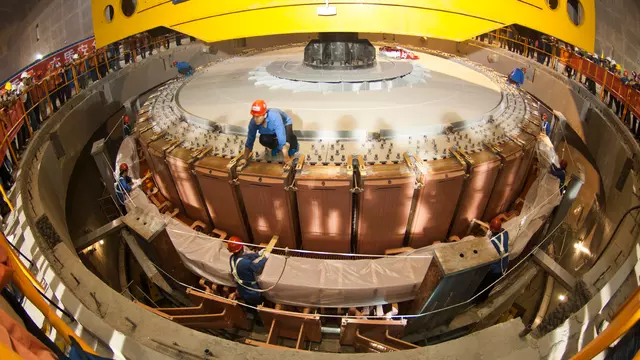XiluoduLaying the groundwork for the next generation of hydropower plants
Having reached many smaller steps over the past decades, the decisive move towards the 1-gigawatt machine is close at hand
Xiluodu Power Plant. County Sichuan, China. July, 31, 2013: Voith engineers cheer up. Around the clock, they were observing the hydropower generator number 8, one of the largest turbine-generator machines in the world, going into commercial operation over the last 72 hours. Proceeding the test with increasing power at its rated speed, the totally air-cooled generator was finally rotating smoothly with 125 rounds per minute producing 784 megawatts. After five years of hard and meticulous labor for the Xiluodu project, the Voith staff reached a milestone in engineering: With a rated output of 855.6 Megavoltamperes (MVA), the Xiluodu power unit is producing more power than comparable Voith machines such as the Itaipu or Guri hydropower plant in South America or Three Gorges in China.

The most powerful generator-turbine unit ever built by Voith entered into service in the Chinese hydropower plant Xiluodu on the Jinsha River. With 855.6 MVA, the output of the generator sets new standards.
With this landmark at Xiluodu on the river Jinsha, Voith is apparently approaching the threshold of 1000 megawatts power unit. Since Voith engineers have been able to improve every detail of the turbines’ and generators’ components, they also raised the machines’ efficiency by applying sophisticated insights into technological methods. Using high tech insulation systems of coils and bars, inventing better materials, and executing a highly precise assembly are many tiny steps towards the one aim: to breach the “1-gigawatt wall”.
In order to deliver best quality at the Xiluodu hydropower plant, Voith did a Ventilation model test at the aviation and aerospace department of Dresden University of Technology in Germany. There is high probability that the first 1-GW machine will go into operation in China, because the second-largest economy in the world is ranking as one of the most important hydropower markets in world.

When Xiluodu hydropower plant was fully connected to the grid in June 2014, it started with a nominal capacity of 13.86 gigawatts. All in all, 18 machine units are in operation. This made it the world's third largest hydropower plant. The plant will help to reduce air pollution thanks to the renewable electricity production of Xiluodu: The annual consumption of coal will be cut down by 41 million tons. In addition to that, exhaust gas emissions will be reduced by nearly 150 million tons of CO2, 480,000 tons of nitrogen dioxide and 850,000 tons of sulfur dioxide per year.
Another advantage of Xiluodu is the ability to deliver base load in large quantity. Xiluodu can produce as much energy around the clock as 14 large thermal or nuclear power plants. As a matter of fact, hydropower technology can bridge the gap between the enormous demand of electricity, and, on the other hand, meet the emission targets our societies have committed themselves to. Thus, Voith contributes to a better future with its climate-friendly technologies.

